McINTOSH BATTERY & OPTICAL CO, CHICAGO, DUAL PILLAR NEW CLINICAL MICROSCOPE #2
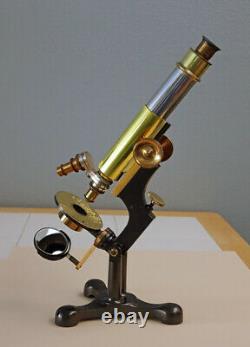
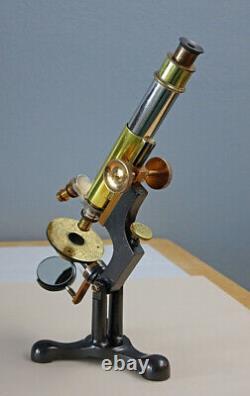
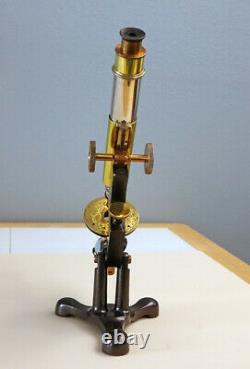
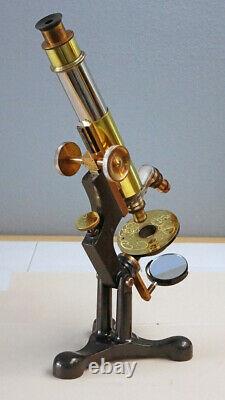
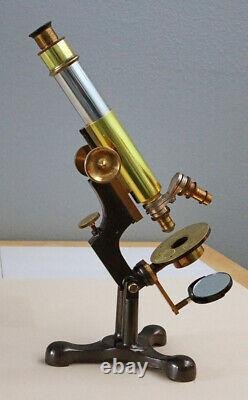


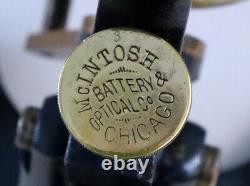

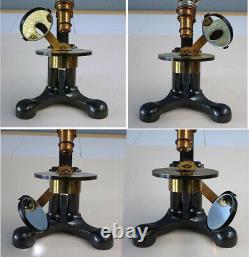
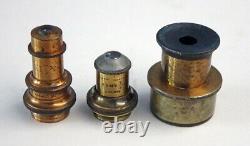


McINTOSH BATTERY & OPTICAL CO. CHICAGO, DUAL PILLAR NEW CLINICAL MICROSCOPE #2.
CHICAGO, ANTIQUE BRASS DUAL PILLAR NEW CLINICAL MICROSCOPE NO. We have carefully restored this antique microscope to near to its original condition (See the STATEMENT OF CONDITIONS below for details). McIntosh produced only a limited number of microscopes during his career, perhaps less than an estimated 1,000 units in number. According to Bracegirdle in his? Notes On Modern Microscope Manufacturers, ?
Serial numbers from 213 to 472 were known when his book was published in 1996. Updating this information to the present day reveals that models found in known private collections and/or that appear from time to time in Internet auctions generally seem to fall within this range of serial numbers. It is also of interest that McIntosh did not sign and/or serialize all of his microscopes.Also, another signed Scientific Microscope No. 2 from circa 1885 in a private collection does not bear a typical serial number. Suffice it to say that the total number produced is quite limited making any of McIntosh?
S microscopes that have survived to this day to be classified as quite rare. NOTE: For more on the history of McIntosh? S optical business, please see below. S New Clinical Microscope No.
2, which consists of a Japanned black tripod foot with integral dual pillars that support the limb with the balance of the instrument finished in lacquered brass. McIntosh produced two (2) versions of his Clinical Microscope. 1 featured a sliding body tube coarse focus system, while the No. 2 model, which he labeled as? Featured a rack & pinion coarse focus system.
Otherwise both models are virtually identical in other respects. This microscope is signed on the top of the round brass head with micrometer screw that controls the fine focus, ? McIntosh Battery & Optical Co. (See close-up image that shows this). This brass head also bears an engraved number, ? I find it very unusual to find such a number at this location on this microscope component. Is this perhaps a serial number for this instrument?That is hard to determine conclusively. Many microscope manufacturers engrave small numbers on individual components that go with the same instrument to help insure that all the components will mesh properly when assembled. Are engraved on inconspicuous places on the part so that they are only visible when one disassembles the instrument.
I found several such numbers on other components of this microscope that all bear the number? So, this leads me to speculate that this number? May be a serial number, reflecting the fact that it was possibly the third in the model series to be produced. Dating this microscope is somewhat problematic based on the above noted information. However, based solely on the name of McIntosh? S company as found on this microscope, namely, ? McIntosh Battery & Optical Company, ? Which was established in 1889 (See history below), we can conservatively date this microscope to circa 1890. Accompanying this listing is a catalogue cut of this same microscope model from one of McIntosh?The similarities to the featured instrument are readily apparent. This microscope is built upon a black Japanned metal tripod base with integral dual pillars. The top ends of the tripod feet are bulbous in nature, which is a distinctive mark of both of the Clinical Microscope models Nos. 1 and 2 and also of the McIntosh Scientific Microscope models Nos.
The dual pillars rise to a trunnion joint that supports the limb and the rest of the microscope. The trunnion joint allows the microscope to be tilted to any angle from the vertical to horizontal. Attached to the trunnion joint is a nicely sculpted Jackson type limb of black Japanned metal. The leading edge of the lower limb is in the form of a disc at the center of which is an L-shaped bracket to which the round stage is mechanically attached with two (2) screws.
This arrangement allows for a space between the limb and the rear of the stage support in order to accommodate a swinging substage mirror assembly, which is described in more detail below. This instrument is equipped with a simple 80 mm diameter brass stage that features some fancy scroll work on its top surface along with a 24 mm diameter central aperture. There is provision for a pair of slide clips, but these are missing from this particular instrument. Under the stage is a brass cylinder that would normally house a disc of apertures. However, this feature is also missing from this microscope. Filling the space between the leading edge of the lower segment of the limb and the rear of the stage support bracket is a rotating mirror support bar of solid brass. This mirror bar supports a yoke mounted 50mm diameter plano-concave mirror at its distal end. The pivot point for this mirror bar is the center of the leading edge of the lower limb at the compass joint so it can rotate around the axis of the stage both below (to provide oblique illumination) and even above the stage to provide incident light to illuminate opaque objects atop the stage (Please see the accompanying composite image that shows the versatility of this arrangement). This appears to be McIntosh?S version of the swinging substage mirror assembly that was first invented and Patented by Joseph Zentmayer in the year 1876. Coarse focus is by rack and pinion controlled by a pair of oversized brass milled heads.
The rackwork on this instrument is horizontal rather than angled. Fine focus is by a micrometer screw with brass head that is found at the top of the limb. This screw acts on a spring-loaded long lever found within the limb. The female dovetail that holds the coarse focus rackwork associated with the body tube is free to move along the front face of the limb.
Thus, when the micrometer screw is rotated the dovetail with the attached body tube moves slightly up or down providing a rather precise form of fine focus. The lacquered brass body tube of this microscope includes a nickel-plated drawtube with a brass ocular holder at the top. At the top of the drawtube in the ocular holder is a? At the base of the body tube is a dual-position rotating objective nosepiece that holds the following objective lenses: An Ernst Gundlach Optical Company dual part ¼?Objective marked with the letter, ? The lower element of this objective can be removed (unscrewed) to allow for low power observations without removing the objective from the microscope.
Also included is a Bausch & Lomb Series I 2/3-inch 0.35 NA objective. NOTE: McIntosh did not manufacture his own objective lenses. Thus, he customarily supplied objectives with his microscopes made by other contemporary opticians including W. Wales, Ernst Gundlach, and Bausch & Lomb.When this instrument is set up for observations with the drawtube fully extended, it stands about 15.5 inches tall. When the draw tube is fully nested into the body tube and the body tube is racked down to its lowest position, the instrument stands about 12.5 inches tall in its collapsed state. The microscope weighs about 6 pounds. There is no wood case or any other accessories that accompany this microscope. NOTE: The accompanying images that were captured under ambient light conditions are a part of this statement of condition.
Please take the time to view each of the images so you can confirm the condition of the instrument and so you will know in advance what you will be getting should you prove to be the proud new owner of this very fine and quite rare American made microscope. In summary, as the accompanying images will attest, this McIntosh New Clinical Microscope No. 2 is currently in very good to excellent cosmetic, optical and mechanical condition. However, this instrument came to us in relatively poor cosmetic condition. The body tube and ocular holder of the draw tube had a considerable amount of tarnish and pitting to the brass, the base and limb had cracks in the Japanned black paint with some underlying rust also being present, and the top of the stage was mostly tarnished partly obscuring the original fancy scroll work. So, we decided to deviate from our customary? Treatment of antique brass microscopes by performing a targeted restoration focusing on the body tube, draw tube, the base and limb along with the round stage to bring the instrument back up to near to its original condition. This involved breaking the microscope down into its basic components, deep cleaning the selected parts of the instrument using a product called? Followed by polishing the appropriate major brass parts and carefully re-lacquering the brass parts with a special lacquer formula to prevent future tarnishing. The base and limb was treated with a paint remover system and repainted with a system to match the original design. Then the microscope was reassembled and tested. The mechanical parts were also cleaned and lubed. Because the instrument as it came to us lacked a substage mirror that was likely lost over the years, we added an appropriate replacement plano-concave mirror from our stock of spare antique microscope parts to make for a completely functional microscope. Note: Please see the accompanying composite image that shows the microscope both before and after restoration along with detailed before and after images of the key restored components noted above.Relative to the optics that accompany the microscope, both the Gundlach and Bausch and Lomb objective lenses are in excellent optical condition with no internal defects present. However, the upper lens element of the 1-inch top-hat eyepiece is missing, but the lower element is present. As a result, in combination with the provided objectives, fully focused images are still formed for the observer, but the fields of view are quite narrow. This should not be a particular concern to the collector as the microscope is most likely to be placed on display in the collection and will not be used on a day-to-day basis in laboratory setting to view specimen slides. The replacement plano-concave mirror is in excellent condition and both sides provide excellent illumination to the stage.
As noted above, both slide clips are missing from the stage and the rotating disc of apertures is also missing from this instrument. The mechanics associated with this instrument are in very good to excellent condition. Both the coarse and fine focus mechanisms work perfectly and smoothly. The swinging substage mirror system rotates smoothly as designed.
All in all, this instrument is a nicely preserved and restored example of a McIntosh Battery and Optical Company New Clinical Microscope No. 2 and is certain to command a prominent place in any antique microscope collection especially since so relatively few of Dr. S microscopes have survived the ravishes to time and circumstances to make it to the present day. McIntosh was a physician-surgeon, inventor, electrician and entrepreneur.
He received his medical degree from Caledonia Medical College in Caledonia, Vermont in 1863. After graduation, he served as a surgeon in the Union Army during the Civil War. After the war, he practiced medicine in Sheboygan, Wisconsin before moving to Chicago, Illinois in 1872.In addition to his medical practice, McIntosh was particularly fascinated with electricity and produced several electrical devices that we now call? Medical devices designed to improve health or to cure disease. He also was fascinated with magic lanterns for use in public displays. In addition, he designed, produced and offered several microscope models for sale?
A total of five different models. Based on information published in his 1895?
Illustrated Catalogue of Stereopticons, Sciopticons, Dissolving View Apparatus, Microscopes, Solar Microscope and Stereopticon Combinations, etc , ? The five (5) microscope models which McIntosh produced consisted of. Model, which was also designed to be used as a part of a Solar Microscope or? And also in conjunction with his Stereopticon?
A type of magic lantern. He was granted a US Patent (# 273,752) in March of 1883 for this model that included a feature that enabled it to be easily detached from its tripod base and incorporated into the solar microscope or stereopticon (magic lantern) setups. This was a dual pillar instrument. 1 had a manual push-pull focus system otherwise known as a sliding body tube coarse focus mechanism, while the No.
2 had a rack and pinion coarse focus mechanism. This instrument featured a fine focus mechanism located under the limb above the rear of the stage. 1 differed from the No.
2 only by being finished entirely in lacquered brass. 2 included both black Japanned metal and lacquered brass parts. McIntosh produced only a limited number of microscopes during his career, perhaps an estimated less than 1,000 units in number. Beginning in the year 1872, McIntosh formed several different companies to offer his inventions and wears to the public. In 1882 he formed the McIntosh Galvanic and Faradic Battery Company.
In 1889, he changed the name of the company to McIntosh Battery and Optical Company apparently to more closely reflect the fact that he offered both electrical and optical instruments for sale. His place of business was listed at 521 to 531 Wabash Avenue in Chicago. In 1883, McIntosh exhibited 11 microscopes at the annual meeting of the American Society of Microscopists. In 1890, he exhibited 5 microscopes and other equipment at the American Society of Microscopists meeting in Detroit, MI. McIntosh died in Florida in 1892 while attending a microscopists meeting there.
Olmsted Scientific Company, which in turn was bought out by the Chicago Laboratory Supply & Scale Company in 1898. It is highly unlikely that the microscope part of the business that was started by McIntosh survived into the 20th Century. THE MONTANA LOGGER is very pleased to offer this McIntosh New Clinical Microscope No. We will also entertain reasonable offers for this very rare instrument. FREE scheduling, supersized images and templates.
Make your listings stand out with FREE Vendio custom templates! Over 100,000,000 served.Get FREE counters from Vendio today! The item "McINTOSH BATTERY & OPTICAL CO, CHICAGO, DUAL PILLAR NEW CLINICAL MICROSCOPE #2" is in sale since Tuesday, September 29, 2020.
This item is in the category "Collectibles\Science & Medicine (1930-Now)\Scientific Instruments\Microscopes, Lab Equipment". The seller is "mtloggera" and is located in Hamilton, Montana. This item can be shipped worldwide.
